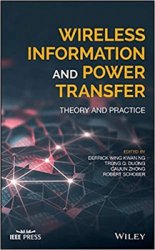Wireless Information and Power Transfer: Theory and Practice
- Добавил: literator
- Дата: 31-10-2019, 17:21
- Комментариев: 0
 Название: Wireless Information and Power Transfer: Theory and Practice
Название: Wireless Information and Power Transfer: Theory and Practice Автор: Derrick Wing Kwan Ng, Trung Q. Duong
Издательство: Wiley-IEEE Press
Год: 2019
Страниц: 305
Язык: английский
Формат: pdf (true)
Размер: 10.1 MB
Wireless Information and Power Transfer offers an authoritative and comprehensive guide to the theory, models, techniques, implementation and application of wireless information and power transfer (WIPT) in energy-constrained wireless communication networks. With contributions from an international panel of experts, this important resource covers the various aspects of WIPT systems such as, system modeling, physical layer techniques, resource allocation and performance analysis. The contributors also explore targeted research problems typically encountered when designing WIPT systems.
The volume bridges the gap between theory and practice, contains an informative introduction to the topic and offers an overview of the important challenges regarding WIPT systems and communications networks. The authors discuss a range of topics including the circuit design, resource allocation algorithm design, and protocol design that addresses the challenges of both theoretical and practical approaches. This vital guide:
Offers an authoritative resource to the fundamentals, research and innovations in wireless information and power transfer
Presents the challenges inherent in WIPT technology and communication networks
Contains information on the history of the development of wireless power transfer and insight on the future of WIPT
Includes contributions from an international panel of experts on the topic
In recent decades, the rapid development of wireless communication technologies has triggered a massive growth in the number of wireless communication devices for various practical applications, including e-health, autonomous control, logistics and transportation, environmental monitoring, energy management, safety management, etc. It is expected that in the era of the Internet of Things (IoT), there will be 50 billion wireless communication devices connected together worldwide via the Internet with a connection density of 1 million devices per km2. In particular, small wireless sensor modules will be unobtrusively and invisibly integrated into clothing, walls, and vehicles at locations which are inaccessible for wired/manual recharging. However, battery-powered wireless communication devices have limited energy storage capacity and their frequent replacement can be costly, cumber-some, or even impossible (e.g., biomedical implants), which creates a serious performance bottleneck for realizing reliable and ubiquitous wireless communication networks. A promising approach to prolong the lifetime of traditional wireless communication systems is to let the wireless communication devices harvest energy from the environment. Wireless power transfer (WPT) offers a viable solution for facilitating efficient and sustainable communication networks serving energy-limited communication devices. Specifically, in practical systems, wireless devices communicate with each other via electromagnetic (EM) waves in the radio frequency (RF) band.
Written for students, researchers, and engineers in the field of wireless communications, Wireless Information and Power Transfer is a comprehensive guide to the theory, models, techniques, practical implementation and application of??wireless information and power transfer.
Скачать Wireless Information and Power Transfer: Theory and Practice
Внимание
Уважаемый посетитель, Вы зашли на сайт как незарегистрированный пользователь.
Мы рекомендуем Вам зарегистрироваться либо войти на сайт под своим именем.
Уважаемый посетитель, Вы зашли на сайт как незарегистрированный пользователь.
Мы рекомендуем Вам зарегистрироваться либо войти на сайт под своим именем.
Информация
Посетители, находящиеся в группе Гости, не могут оставлять комментарии к данной публикации.
Посетители, находящиеся в группе Гости, не могут оставлять комментарии к данной публикации.
